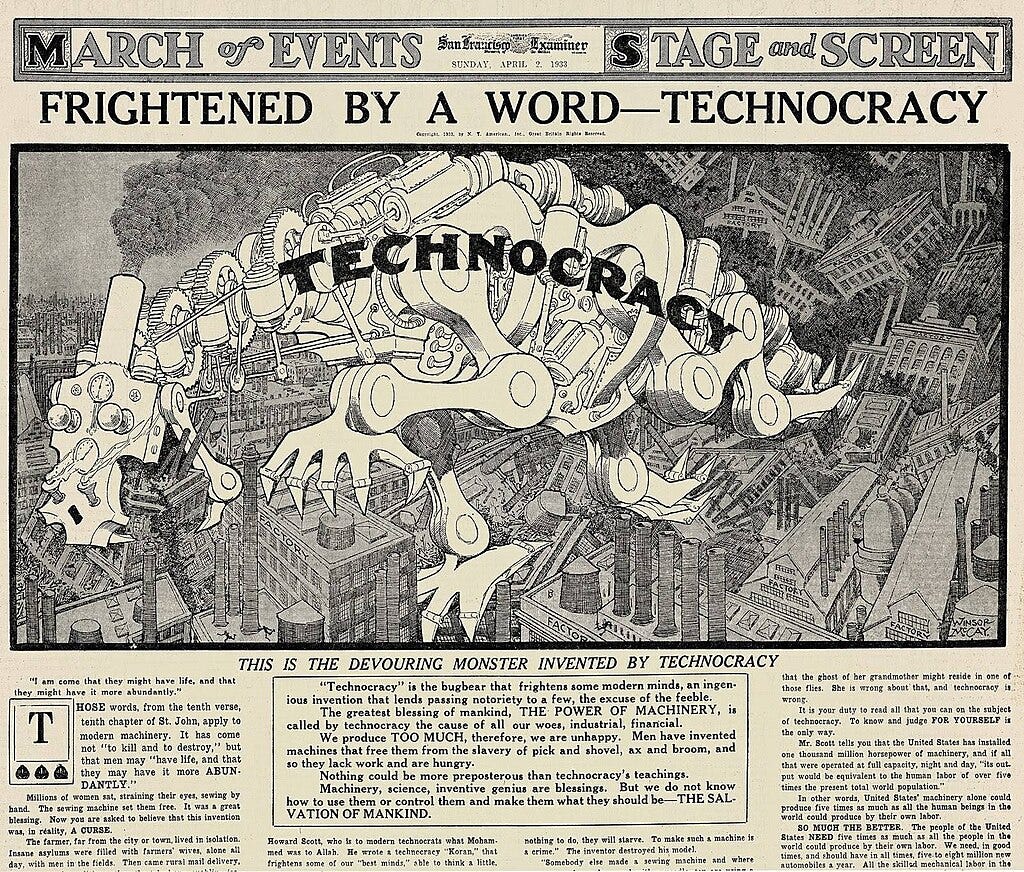A Perfect Cage: How the System Consumes Resistance
You Never Saw the Bars. That’s What Makes It Perfect.
Hey, Slick!
There are no guards. No walls. No chains.
And yet, you stay…
The old dystopias were crude—repression through brute force, propaganda, and obedience. Today’s system is far more elegant; you aren’t forced to comply with the system. You choose to. You defend it. You fear life outside it.
Surveillance capitalism turned resistance into engagement, rebellion into revenue, and dissent into data. Every act of defiance is anticipated, monetized, and absorbed. The more you try to fight, the deeper the system pulls you in.
This is the Perfect Cage. We aren’t living in Orwell’s 1984 or Huxley’s Brave New World; those were crude prototypes compared to what we have now. The Perfect Cage is something else entirely:
Total surveillance. Every action tracked, every thought inferred.
Total entrapment. Any attempt to resist only strengthens the system.
Total cynicism. If nothing matters, why fight? If resistance is futile, why try?
This isn’t a dystopian future. It’s happening now. And the worst part, Slick? You already know it.
And yet, here we are.
So the real question isn’t whether you’re trapped.
It’s whether you ever knew how to escape in the first place.
I. The War on Anonymity: Attacking the Last Safe Haven
The latest frontier in control is the total elimination of anonymity. Not with guns or prison cells, but with metadata tracking, algorithmic preemption, and the slow erosion of every space where anonymity once thrived.
Sources are no longer protected. Every leak, every whistleblower, every journalist’s confidential informant is at risk of exposure through metadata tracking, AI-driven pattern analysis, and mass data collection—if not outright attacks on authors and media who use anonymous sources.
Encrypted messaging apps aren’t truly safe. Your messages may be encrypted, but your movements aren’t. The system doesn’t need to read what you say—it only needs to know who you talk to, when, and how often, to map networks of dissenters without reading a single message.
The drive to eliminate anonymity online. Proposals for ID verification for social media and digital platforms mean that soon, speaking out without consequence could be impossible.
Leakers don’t have to be silenced—they just have to be made untrustworthy. The algorithm can manufacture a scandal faster than you can finish reading this sentence.
And they may not even have to. Every life worth living is full of crispy details. What can a government whistleblower do if the very private information contained in any SF-86 background check were to fall into the wrong hands? We’re talking mental health records, financial history, personal relationships, and past struggles. Who will ask questions if anyone who gets flagged for instability or a loyalty risk never get a second chance?
So, Slick, what happens when there is no place left to speak freely?
This is the latest escalation, but it’s just one piece of a much larger structure. The cage has been under construction for years—now it’s nearly complete.
II. The System Knows Everything—And It’s Only Getting Worse
We gave away our privacy, Slick. And for what? For free WiFi, for convenience, for likes and clout. We moved our entire lives online without ever questioning the walled gardens we were stepping into. And now, the system knows everything.
Your contacts, conversations, and locations. Metadata alone reveals your habits, your network, your dependencies. Palantir, the government’s secretive data analytics partner, can process connections between individuals, tracking relationships at scale, mapping who you know, who you talk to, and what you believe.
Your medical history, tax records, employment history. The IRS, health insurers, credit agencies—each feeds into a growing database that can assess not just your financial worth but your potential as a risk to the system.
Your desires, insecurities, and fears. Your search history, engagement patterns, and scrolling behavior form a psychological map of what breaks you, what enrages you, and what can be used to manipulate you.
And it’s not just the government. Private tech companies have built their own total surveillance networks.
Your phone, your laptop, your smart speaker—each one a wiretap you willingly installed. Whether it’s Siri, Alexa, or Google Assistant, your voice is being captured, stored, and analyzed—if you haven’t been hacked or gathered spyware.
Teslas and other smart cars are rolling CCTV systems. Constantly mapping locations, scanning nearby phones, recording conversations inside and outside the car. Next time you see one, pause, Slick. Watch it record you in real time. Now scale that to every street, every highway, every city.
Starlink could soon route global telecommunications traffic through a private, military-adjacent infrastructure. Imagine a world where every phone call, text, and online interaction is routed through a system controlled by a few corporate hands, bypassing national networks entirely.
Hackers scrape this data for profit. Governments use it for control. But the real power lies in their partnership. A seamless fusion of state intelligence and corporate infrastructure, eliminating the last barriers to total control.
So, let’s make it real. They already know, or could know, the following about you:
Your location history down to the meter, every minute of your life.
Your full psychological profile, drawn from search history, spending habits, and even your facial expressions on recorded video.
Your entire contact network, mapped by metadata, devices in proximity, and algorithmic analysis of message content.
Your health status, vulnerabilities, and genetic risks, thanks to medical records and biometric tracking.
Your ideological beliefs, inferred from what you read, who you interact with, and how you phrase your emails.
Your likely future actions, based on all of the above.
Could you resist if every move you made was anticipated? If they knew your weaknesses before you did? If they could make your rebellion irrelevant before it even started?
III. The Absorption and Monetization of Rebellion
Rebellion has always been repackaged, resold, and reabsorbed. Punk, hip-hop, grunge—what started as raw defiance was polished, commodified, and sold back to the same kids who once raged against the machine. MTV turned subversion into style. Shepard Fairey’s Obey the Giant began as anti-establishment street art; now it’s a brand, a logo, a neatly packaged rebellion-for-purchase.
Naomi Klein’s No Logo laid it all bare: corporations hijack counterculture, strip it for parts, and spit it back out as a marketing campaign. But exposure changed nothing. Knowing the playbook didn’t stop the cycle—it just made cynicism part of the aesthetic. Every act of defiance becomes a trend, a lifestyle, a product. Even the language of resistance is optimized for engagement.
Rebellion used to mean selling out. Now, you're pre-monetized. The system profits from your outrage before you even take your first step.
You don’t just buy the t-shirt—you generate engagement, feeding the very platforms you think you’re fighting.
Your anger is fuel. Rage-clicks, arguments, and callouts drive ad revenue.
Your ‘activism’ stays inside their ecosystem. Every protest thread, every viral outrage cycle—on their servers, under their control.
You believe you're mobilizing, but you're really just creating content. And the system knows: as long as a like, a share, or a hashtag feels like action, you’ll never take it further.
The algorithm doesn’t just monetize rebellion—it metabolizes it. It absorbs, redirects, and preempts.
What you see, what gets amplified, what gets buried—it’s all curated.
Controversy is engagement. Outrage is profitable.
Social movements are just another dataset—analyzed, weaponized, shaped by forces far beyond the people on the ground.
This is the Perfect Cage: a place where even resistance is data, where every act of defiance is just another signal to track, another product to sell.
And yet, it goes deeper—because they don’t just own the conversation. They own the entire battlefield.
IV. The Privatization of Control: Who Owns the New Security State?
The commons are gone. Platforms that once resembled public squares are now corporate-controlled fortresses where speech is governed not by democratic laws, but by opaque Terms of Service. Rights are no longer rights—just temporary privileges, revocable at any time.
The architecture of control is private. Government surveillance has merged with private intelligence networks like Palantir and Clearview AI, forming a shadow state with no accountability. The lines between public power and corporate control no longer exist—because the same tools are used by both.
You don’t need a secret police when you have predictive algorithms. You don’t need mass arrests when you can quietly flag, throttle, and erase.
Meanwhile, private security forces like Triple Canopy and Gavin de Becker & Associates are replacing public enforcement. The billionaire class has realized they don’t need national militaries or police—they can buy their own. Security is now a commodity, and loyalty belongs to the highest bidder.
And when policing is privatized, so is suppression.
What does that mean, Slick?
A government that still has laws, but no power to enforce them—except against those who lack protection.
A police force that exists, but only for those who can afford its services.
A justice system that exists in name only—where enforcement is selective, softened by corporate influence, and quietly settled through NDAs, out-of-court deals, and legal loopholes designed to protect the powerful.
Dissent isn’t punished through arrests—it’s neutralized by cutting people off from everything: jobs, housing, banking, social infrastructure.
The penalties for stepping out of line aren’t violent—they’re silent. You won’t be dragged to a gulag. You’ll just lose access. Your accounts will freeze. Your insurance will lapse. Your job prospects will dry up. Your presence will shrink into nothing.
And you’ll have no recourse, because no one is responsible. No courts to appeal to. No officials to petition. Just an endless loop of "Your case does not meet our criteria for review."
A government can be held accountable, at least in theory. A corporation? It simply updates its Terms of Service.
And yet, it goes deeper. Because once enforcement is privatized, so is reality itself.
V. Predictive Suppression and the Remaking of Reality
If you stare into the abyss, the abyss stares back. But now, it’s not just the system watching us—it’s us watching the system, feeding it, giving it everything it needs to predict, shape, and control us.
We don’t just fear the algorithm; we live through it, think through it, optimize ourselves for it. We let it define us, structure our reality, and in the process, it remakes the world in its own image.
The real horror of the Perfect Cage isn’t that it watches you—it’s that it sees you coming.
AI-driven surveillance doesn’t wait for rebellion—it preempts it.
Dissenters aren’t jailed or silenced—they’re shadowbanned, de-banked, erased from relevance.
Government records, Starlink surveillance, financial tracking—every data point locks into place, tightening the cage before you even see the bars.
And beyond that, there are the dirtier tools:
Not just disappearances from public life, but from the grid itself. No formal charges, no due process—just gone.
Deepfake discrediting—a leaked video, an AI-generated scandal, a manufactured accusation. Plausible deniability is the ultimate weapon.
Loyalty tests and ideological purges—and not just for governments: corporations, media, and even friend groups quietly enforce the new regime of acceptable thought.
But suppression is only one piece of the puzzle, Slick.
Modernity itself is a system of seeing, measuring, and controlling reality.
For centuries, the modern world has been driven by quantification, data, and reductionism—what can be measured, optimized, and predicted. In this view, the world is not a mystery to be experienced but a problem to be solved.
And now, the machine has turned this view onto us.
Your emotions, thoughts, and habits are data points, processed and optimized.
Your work, passions, and ambitions are numbers—productivity metrics, engagement rates, revenue streams.
Your very existence is being collapsed into an algorithmic model, too narrow to capture what makes you human.
But what if the model is flawed?
What if AI hallucinations, missing context, and incomplete data points are not just quirks, but structural blind spots?
What happens when an entire system of control is built upon a misreading of reality?
What if the AI predicting dissent is working from a map with half the roads missing?
What if the models ignore the things that truly drive people—intuition, emotion, the unquantifiable?
What if the perfect cage is, in the end, built on an illusion?
Neil Postman once asked of technology: What is lost in the process? What happens when we trade depth for efficiency, complexity for simplification, wisdom for knowledge, and knowledge for mere information?
We are being conditioned—through our screens, through our data, through our need to optimize and monetize everything—to think like the machine, to reshape our own existence in its image.
We are told to be efficient, productive, scalable. We pursue side hustles, passive income, personal branding—turning ourselves into economic units, perfectly integrated into the system.
But in this process, something more fundamental is slipping away, Slick.
The slowness of deep thought, replaced by the speed of reaction.
The ability to be present, eroded by the need to always be seen, always be producing.
The mystery of being human, flattened into patterns and predictions.
Reality itself is being remodeled—not just through surveillance and control, but through the very way we are trained to think.
And the next step? AI ensures the process never stops.
The system doesn’t need to stop you from rebelling. It just needs to make sure you never find the ground beneath your feet.
And when reality is no longer ours, the final step is complete.
The cage isn’t just around us—it’s inside us.
And once that happens, who even thinks of escape?
VI. The Algorithm Owns Reality: The End of Independent Thought
Total suppression isn’t even necessary—because the system is designing a world where rebellion doesn’t make sense.
Reality is now mediated entirely through screens and algorithmic curation. If it’s not seen, it’s not real. If it’s not trending, it doesn’t matter.
You don’t even have time to process what’s happening. Doomscrolling, outrage cycles, rapid-fire scandals—before you can react, the system has moved on.
Even authoritarian symbolism becomes untraceable. The speed of the news cycle makes it impossible to track slow-moving ideological shifts. A Nazi salute at a political rally? Forgotten in a day. An erosion of rights? Absorbed into the background noise of endless, overlapping crises.
Cynicism ensures inaction. People burn out before they mobilize. Attention spans are fragmented. Grandiose speeches are meaningless, and political theater replaces real change.
Every day, we watch the same empty rituals unfold:
A politician gives a speech about “protecting democracy.” Do you think their words will stop authoritarian drift?
A corporation changes its logo for Pride Month. Will they stop union-busting, paying starvation wages, or lobbying against climate policies?
A billionaire tweets about wealth inequality. Will they redistribute their fortune, or just collect engagement while their workers live paycheck to paycheck?
A world leader issues a statement of concern over a genocide. Will it change anything, or just serve as a pressure valve for public outrage?
And then, we play our part, too.
We watch the speech, maybe even share it.
We nod along, feeling something between frustration and validation.
We post, comment, argue.
We tell ourselves we’ll do something about it.
We even believe it for a moment.
And then? We move on, like we always do. Because we can’t stay in a state of perpetual indignation. We can’t wake up every day consumed by outrage, unable to talk about anything else. If we did, we’d never get anything done, never laugh, never live. And so, we stop caring—or at least, we look like we do.
Because we have to. There’s a mortgage, a job, a family. There’s the quiet knowledge that stepping too far out of line has consequences. The system doesn’t need to stop us—it just needs to make resistance impractical, exhausting, self-defeating.
And in that moment, something inside us fractures—the gap between what we know and what we do. We know the outrage is fleeting. We know nothing will change. But we still go through the motions, convincing ourselves that maybe, this time, things will be different. This is cognitive dissonance at scale, engineered and refined.
And then comes the final layer—AI-driven entrapment.
The algorithm personalizes your cage. Your newsfeed, your entertainment, even your friends are curated to reinforce your specific worldview. Everyone exists in a personalized simulation.
Community dissolves into the matrix. The connections that once defined human resistance—family, community, face-to-face relationships—are eroded by endless distraction.
Rebellion becomes impossible because collective reality no longer exists. If the truth itself is unknowable, if every fact is debatable, if every narrative is an echo chamber—what is left to fight for?
And this is just the beginning. The next step? Direct biological integration.
Rushkoff warned of control chips, neural implants, and biometric tracking. What happens when thought itself is processed through a system that can nudge, redirect, or suppress before it even reaches consciousness?
Elon Musk’s Neuralink and other BCIs (brain-computer interfaces) will reshape reality at the neurological level. At first, they will be marketed as tools for communication, for efficiency, for enhancement. Then, they will become the system’s final gatekeeper.
When your thoughts, impulses, and desires are mediated through corporate and state-controlled networks, where does agency begin and end?
Reality itself is being rewritten. The system doesn’t just track your behavior—it restructures how you perceive the world. A perfect cage doesn’t need locks if the prisoners no longer believe in escape.
VII. Final Thought: Can You Still See the Cage?
This isn’t a dystopian future. It’s now. The walls are built, the doors are closing, and the Perfect Cage doesn’t even need locks—because you never see the bars.
And it’s too much to process, isn’t it, Slick? It just seems... unreal. Someone should do something. But who? And what? And how?
You already know how it goes. A moment of indignation, an urge to act, a voice inside whispering, this time, this is too far. And yet, the urgency fades, the moment passes, and life continues. You ration your outrage. You compartmentalize. You make space for normalcy, even as you know, deep down, that none of this is normal.
The system doesn’t need to stop you—it just needs to make resistance impractical, exhausting, self-defeating.
And what if that was always the plan?
What if you’ve already been shaped by the very system you thought you were resisting? What if the thoughts in your head, the words you speak, the way you process reality—are all products of an architecture designed to contain you?
What if even your defiance was expected? What if the system knew you would push back—just enough to feel alive, but never enough to matter?
Maybe the first crack in the system isn’t rebellion. Maybe it’s seeing the cage for what it is—and realizing it has already done its work.
And that means we need a different answer—not just another protest, another outrage cycle, another fleeting moment of defiance that fuels the same machine. If every reaction is absorbed, then what’s left isn’t resistance. It’s something unpredictable. Something the system cannot process.
But what? And how? That’s the real question, the one we’ve been avoiding. Because the system doesn’t fear your resistance—it has already metabolized it. If every movement, every protest, every act of defiance can be absorbed, then the only way out starts with something it cannot see coming.
But what does that look like? Could you even recognize it if you saw it? Or has the system already trained you to dismiss the only thing that might actually work?
So, Slick, if resistance is just another cog in the machine, and escape was never part of the blueprint—then what’s left?
Is there a way out? Is there even an ‘outside’ anymore?
If escape is impossible—if every act of defiance has already been predicted—then maybe survival demands something else entirely. Maybe the real question isn’t whether resistance is possible—but whether you've already been conditioned to avoid a path that could have led somewhere different.
And if the system has already shaped your every move, maybe it never needed to stop you—because escape was never an option to begin with.
Except, perhaps, for the poets.
But that’s a story for another day, Slick.
And we’ll get to it—because if the cage is real, then so is the need for an answer.
And for today? That’s enough. I know. I’m sorry.
So here’s something beautiful for the road. Because I, too, am for the birds, not for the cages, America...
In the meantime,
Stay Slick
Next:














Thanks again Slick! You must also have forgone social media as a way of learning years ago, and seen the zombification as an outside observer. My personal solution is to stay grounded in printed media, attend gatherings of people in real life several times a week, and serve others in the real world. All those done collectively could end their power over us, short of nationalizing all of Big Tech under an elected government of the people.
I'd like to see some hacker develop a plague virus that chews through the entire Infrastructure of Metadata Manipulation.
Hackers. They just don't seem to pick the right targets.